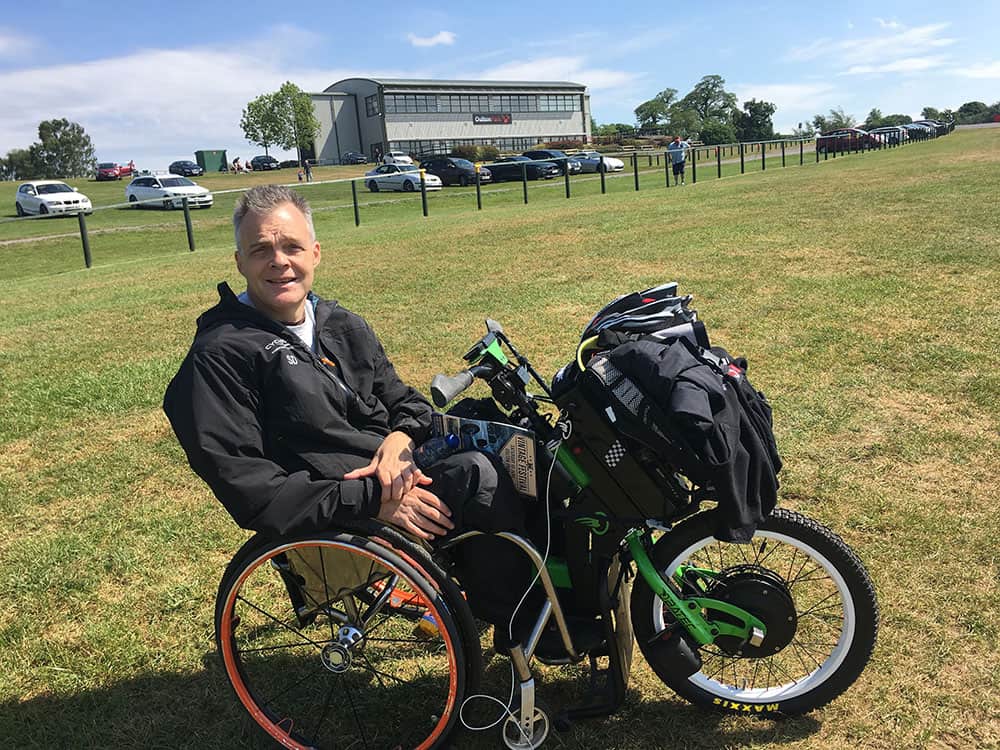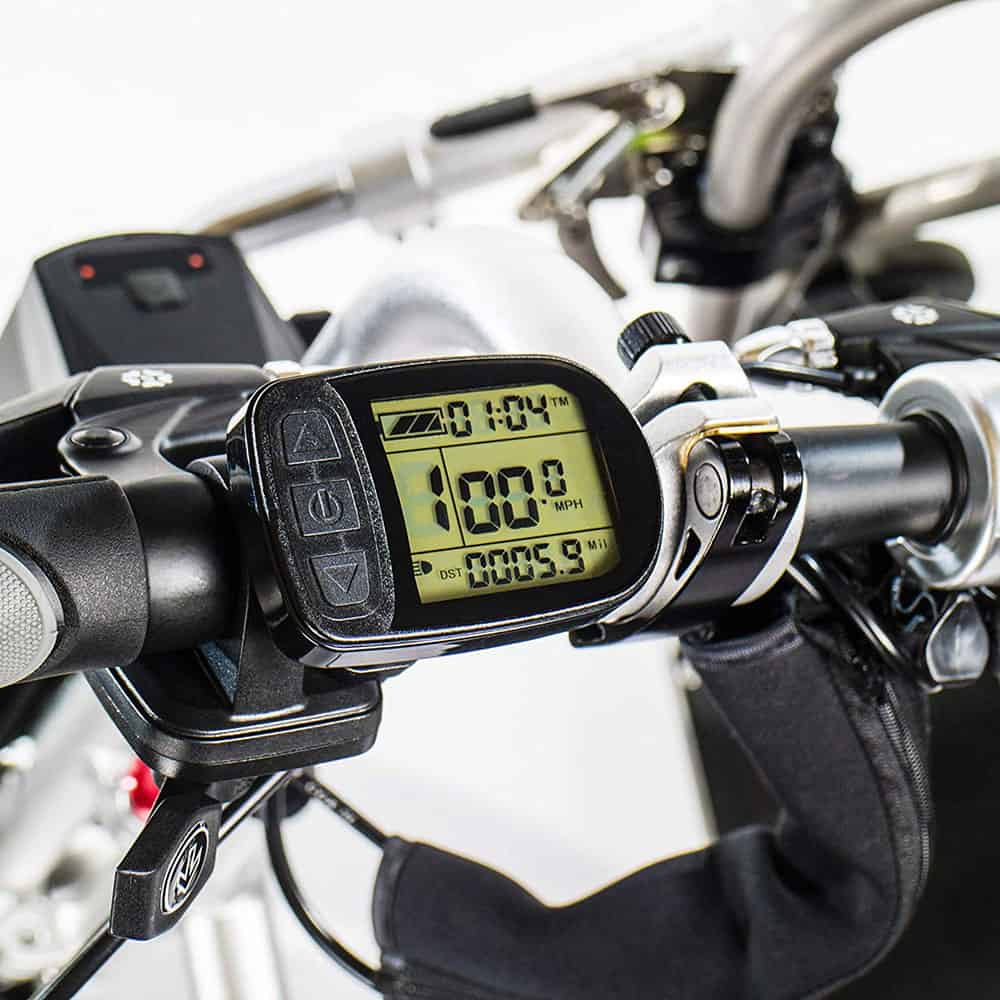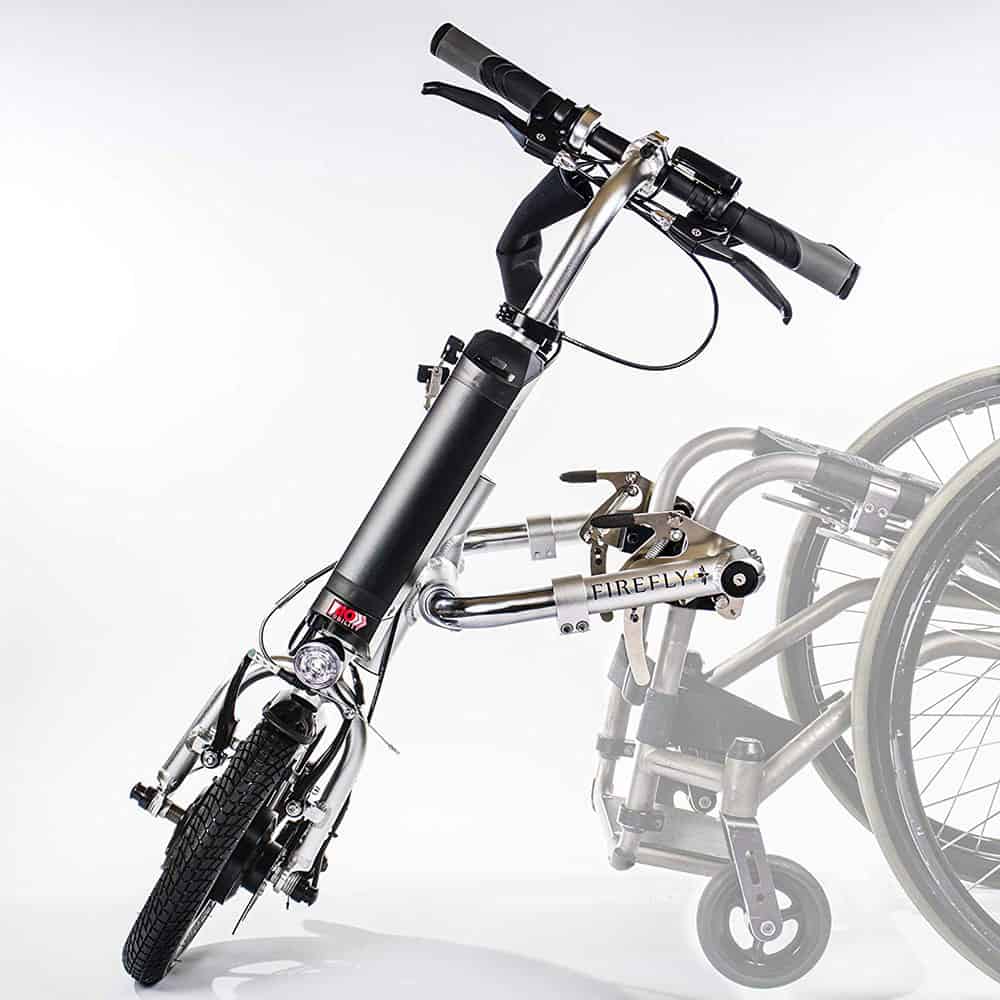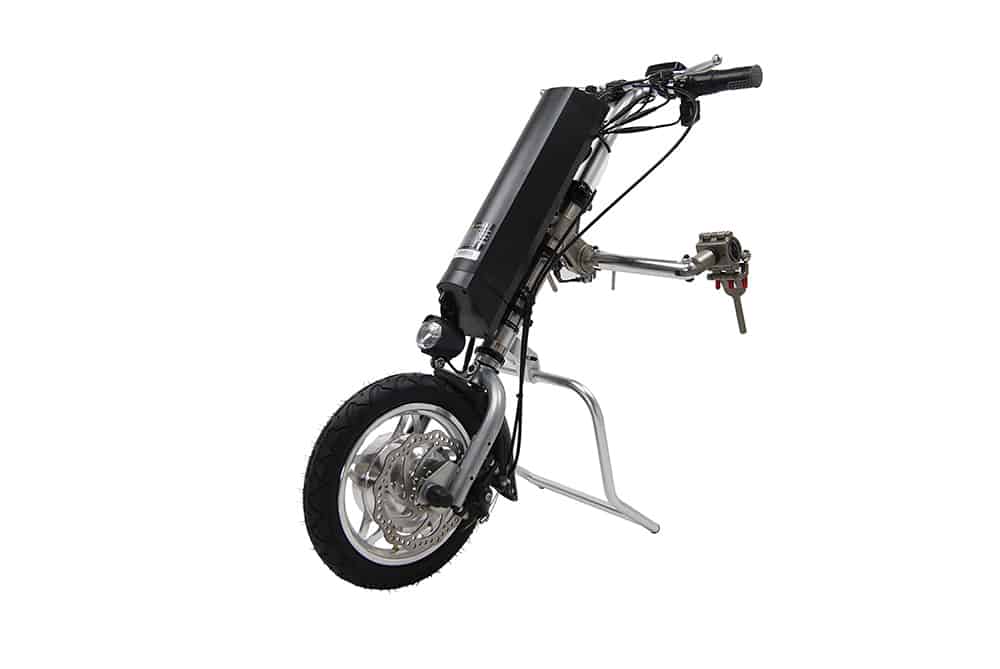Powered handbike attachments: A regulatory grey area?

An emerging and rapidly growing area of the mobility market is power add-on devices designed for manual wheelchairs, with a growing number of suppliers and retailers providing a range of products aimed at giving wheelchair users an extra boost. Many in the industry, however, have commented that there is a large degree of regulatory confusion surrounding this relatively new product segment, and none more so than in the powered handbike attachment category.
Powering up the market
Designed to give users the benefits of a powerchair whilst retaining their own wheelchairs, wheelchair power add-ons are proving an increasingly popular choice for wheelchair users.
The growth in popularity amongst end-users has led to a rise in the number of power add-on players in the industry.
Established suppliers such as Invacare and Sunrise sell a range of power add-ons, new market entrants from mainland Europe such as Triride and Batec are gaining market share, and new suppliers such as the Mountain Trike Company with its recent eKit power add-on are joining the sector.
Alongside the growth in suppliers, an increasing number of dealers are stocking and selling the devices, providing lucrative cross and upsell opportunities to keen customers.
Driving demand
Discussing the growth in wheelchair power add-ons in general, Ryan Gratrix, Managing Director of mobility specialists GRX Life, commented: “Power assist as a whole is certainly a growing part of the market. Over the years, so many active users have had to make the transition into the more traditional, heavier powerchairs because of problems such as shoulder issues. This often means not just changing their wheelchair but all aspects of their life, such as changing their car and modifying their home, just to name a few.
“A wheelchair is an extension of a person’s body, so it is easy to see the appeal of these lightweight alternative solutions that enable people to stay in the chairs they know and love.”
According to Ryan, with wheelchairs having evolved and developed so much over the last few years, end-users are seeking to do more and are turning to the devices.
“GRX Life specialise in providing bespoke solutions to fellow active wheelchair users. Traditionally, this has been all about providing the lightest possible wheelchair that meets their clinical needs, expectations and wheelchair skills. Nowadays, however, customers almost see this as the baseline, so naturally, the next thing they ask is what else they can get to help them go further and do more.
“You only have to look around Naidex to see how many accessories and add-ons are coming to the wheelchair market to meet this consumer demand. Power add-ons are definitely one of the biggest areas of growth today.”
Echoing Ryan’s remarks, Stuart Dunne, Managing Director of Cyclone Mobility, said: “The market for add-ons is becoming increasingly popular because wheelchair users like the freedom that a manual chair gives, but long distances require an incredible amount of stamina which can only be found in athletic paralysed individuals.”

The different types of power add-ons
The market for power add-ons is diverse, with various styles and models available on the market, providing assistance in different ways to end-users.
There are a range wheelchair powerpack options, including push assist devices aimed at making pushing manual wheelchairs easier for either an attendant or an end-user; powerpacks featuring a joystick, blurring the lines between a traditional electric wheelchair and manual chair; add-ons which attach a powered third wheel to a chair, providing the power assist from the front of chair.
In addition, there are popular manual, hybrid and powered handcycle attachments available on the market, turning the wheelchair into a trike and changing how it is classified in the eyes of the law.
Rules of the road (and pavement)
Advising on the rules governing how these devices should be used legally on roads and pavements, John Preston Healthcare has worked hard to provide clarity to its customers, creating an informative, comprehensive online article detailing the rules and regulations relating to powered attachments.
“Legislation relating to road and pavement use is lagging behind product innovation and definitely causing confusion.” Andrew Stevenson
The mobility retailer points out in the article that manual wheelchairs are categorised as a Class 1 Invalid Carriage under ‘The Use of Invalid Carriages on Highways Regulations 1988’, whilst electric wheelchairs fall under Class 2.
Importantly, John Preston Healthcare states that wheelchair power add-ons, despite being “CE marked as medical devices, are in themselves not invalid carriages, as they are merely an accessory designed to fit a class 1 manual wheelchair.”
Whilst this means there could be potential confusion as to how wheelchairs with power add-ons are classed (either class 1 or class 2), the rules relating to both classes for use on pavements are similar.
John Preston Healthcare confirmed advising users to adopt the rules for class 2 invalid carriages in terms of only being used on pavements and in pedestrian zones – not on roads, except to cross the road or for short distances when the footpath is inaccessible – and not exceeding the 4mph speed limit.
Not completely watertight, for most powerpacks and power add-ons, this seems to suffice. The problem, however, lies in handcycles.
What rules govern wheelchair power handcycles?
When a power handbike attachment is used with a manual wheelchair, the wheelchair handcycle attachments fall under bicycle and e-bike regulations.
This change in status from invalid carriage to e-bike is significant, as the end-user is required to adhere to new rules when using their wheelchair and handbike attachment, differing to the rules applied to class 1 wheelchairs.
This is where some of the confusion surrounding how the device should be used legally begins.
John Preston Healthcare notes: “Handcycles are road legal as they are treated as bicycles.
“Like with e-bikes, the legislation about motor wattage is on the move and is being increased.”
If the device is classed as a bicycle and is no longer deemed to be an invalid carriage in the eyes of the law, then does this mean that the user is subject to all the same rules governing bicycles, such as use on footpaths & bicycle lanes and lit white and red rear lights at night?
Manual, power-assist and powered handcycle attachments
The real confusion sets in when examining the difference between the different handcycle add-ons on the market and the laws governing them.
Handcycles can be split into manual and power-assist options with pedals, as well as powered options without pedals; it is this distinction of pedals that is important.
Guidance from the Department for Transport in November 2015 for Electrically Assisted Pedal Cycles in Great Britain – which wheelchair handcycles fall under – highlights that a cycle must be fitted with pedals that are capable of propelling it, the maximum continuous rated power of the electric motor must not exceed 250 Watts, and the electrical assistance must cut-off when the vehicle reaches 15.5mph.

Importantly, the guidance makes specific mention of powered handcycles for the mobility market, noting: “Because of the particular benefits for elderly and disabled users, pedal cycles providing electrical assistance without use of the pedals – usually called “Twist and Goes” – are included in the above GB classification provided they are capable of pedal operation and comply with the above restrictions on maximum motor power and assistance cut-off speed.”
Whilst this covers manual and power-assist handcycles, the guidance omits power handbike attachments with no pedals, as pointed out by Cyclone Mobility’s Stuart Dunne.
“Unfortunately, it doesn’t seem to cover the types of vehicles that are presently available on the market,” he said.
“The products range from 250w to 3000w motors that have speeds from 10 mph to in excess of the 15.5 mph but the only other means of propulsion other than gravity is the wheelchair users’ rear wheels.”
The Department for Transport’s guidance also highlights that under Regulation (EU) No 168/2013 of The European Parliament and of The Council dated 15 January 2013, new “Twist and Go” vehicles will, from January 2016, have to meet a range of technical requirements before they can be used on roads.
However, the EU regulation also clearly states this does not apply to “vehicles exclusively intended for use by the physically handicapped” – extending to power handbike attachments which are considered medical devices and CE marked.
A regulatory blackhole
The lack of clarity and contradictory information leaves a lot of room for interpretation when it comes to what specifications these products should meet and not exceed in the market, as well as what advice end-users should be given when it comes to using the devices.
If a powered handcycle with no pedal is used, does the wheelchair then fall back under invalid carriages regulation? Should users use the device on footpaths or on the road and in cycle lanes? Does the speed need to be restricted to 4mph on pavements? Does the max speed need to be limited to 15.5mph? Is the device still classed as an e-bike? Does the status change to that of a “powered transporter”, a term used to cover a variety of novel and emerging personal transport devices which are powered by a motor, including e-scooters, hoverboards and segways?
“I’m hugely concerned that the powers that be in the Department of Transport or Vehicle Standards aren’t setting clear rules” Stuart Dunne
THIIS contacted the Department for Transport for clarity regarding what a wheelchair with a powered handbike attachment is classed as under the law.
A policy advisor for the Department commented: “The classification of mobility scooters is a function of the Department for Health and so the newer powered add-ons for manual chairs would need to be considered by them in the first instance. Once a decision is made on how they are classified then it would be for this Department to ensure that they are either covered by the existing policies or to ensure the corrective action is taken to get them included.”
The lack of regulatory clarity surrounding the products has been highlighted by various retailers in the industry, with Cyclone’s Stuart Dunne stressing that it is an area that needs to be addressed quickly.
“I believe we need a lot more clarity as these vehicles are becoming very popular,” he stated.
“I’m hugely concerned that the powers that be in the Department of Transport or Vehicle Standards aren’t setting clear rules. Many other manufacturers are clearly using this to supply what I would deem to be unsafe equipment that travels at speeds of in excess of 30mph and power up to 4000watts.”
What do retailers advise?
Despite a lack of regulatory clarity, the powered handcycle market continues to grow, with more products entering the market and more retailers introducing models to their product portfolios for eager customers.
The advice from John Preston Healthcare to customers is to adhere to the class 2 invalid carriage rules, in spite of “some wheelchair power attachments [being] capable of very high speeds of up to 16mph & more” and “no speed restriction for manual wheelchairs on public paths and in pedestrian zones.”
In addition, the mobility retailer highly recommends users “wear high vis clothing, a safety cycle helmet and mount a high vis flag on to your wheelchair when cycling on the road.”
When asked what Cyclone Mobility recommends to its customers, Stuart’s response echoed John Preston’s guidance: “We advise that when travelling on the road, a safety helmet is advisable but not law. We also advise that the built-in light system should be turned on at all times and that when travelling on pavements, the walk speed selector should be chosen as this regulates the speed to within class 2.
“We also advise that clear safe clothing should be worn and customers go through a full induction of safe use.”
A supplier’s view
Considering the regulatory position of power handcycles in the market, Nathan Milgate, General Manager of power add-on specialists Triride for the UK, told THIIS: “Currently, we treat a manual wheelchair when used with a Triride as a pavement product, so in speed setting 1 we have a limit of 4mph to follow regulations of a class 1 vehicle. We develop our own electronic controller and have the ability to easily program to country-specific regulations.”
Whilst the regulations in the UK are not crystal clear, Nathan stressed the power attachment supplier gives the information and features needed to ensure end-users remain safe when using the devices.
“We provide lights on all of our products at delivery and suggest to all of our dealers that a helmet is used when using the product,” he explained
“When the handcycle is used in conjunction with the wheelchair, bicycle regulations should be followed and we provide education to our dealers who at handover will educate the end-user.
“In addition, we strongly recommend product insurance through one of the many insurers available. I know specifically Lockton and Fish insurance have policies available for this type of product. Whilst it is not mandatory, it is strongly recommended by us and our dealers.”’
Not slowing down

Regardless of the lack of regulatory clarity in this sector of the market, it is clear from the growth and demand from end-users that there are no signs of it slowing down.
Outlining why the market continues to expand, Triride’s Nathan said: “I would say ease of use is one thing driving that demand, as it attaches to your existing wheelchair without the need for a second wheelchair or dedicated alternative handcycle. Recreational fitness also plays a big part in handcycle attachment demand.
“But most of all, it comes down to inclusion in daily living. A wheelchair handcycle is an add-on device, not a powerchair. With a powerchair, lifestyle changes dramatically, such as a Wheelchair Accessible Vehicle being required, whereas our handcycle attachment can be removed easily and transported in a regular vehicle.
“As a user myself, the possibilities and worries of travelling in a wheelchair are no longer a concern, as the handcycle does the challenging work when I encounter a steep hill or uneven terrain, not limiting my access to different environments.
“Lastly, the health benefits. Wheelchair users stress their shoulders dramatically over years of use so a power-assisted handcycle aide still keeps users active but assists at the same time, reducing the stress on shoulders and upper limbs for manual wheelchair users.”
Whilst there are those responsible retailers and suppliers filling the regulatory gap with sensible advice and models, there is always the risk, however, that such a lack of clarity is open to exploitation by the less scrupulous in the future, as pointed out by Stuart.
According to the Department of Transport, an international meeting discussing all aspects of motorised equipment and whether the motorised add-ons required classification is due to take place shortly.
Speaking with the British Healthcare Trades Association’s interim Director-General Andrew Stevenson about the lack of clarity in the growing product category, he finished: “Legislation relating to road and pavement use is lagging behind product innovation and definitely causing confusion. The UK government has set itself a “Future of Mobility” challenge across all types of transport and BHTA will be urging them to address this problem.”
Mobility vehicle classifications
Wheelchairs, powerchairs and mobility scooters are all defined as an invalid carriages in ‘The Use of Invalid Carriages on Highways Regulations 1988’ and fall into three categorisations:
Class 1: manual wheelchairs – not electrically powered and intended for footpath or pavement use only
Class 2: powerchairs and mobility scooters – intended for footpath or pavement use only, with max speed of 4mph
Class 3: powerchairs and mobility scooters – for use on road, with a max speed of 8mph on roads and the ability to limit speeds to 4mph on pavements
https://thiis.co.uk/powered-handbike-attachments-a-regulatory-grey-area/https://thiis.co.uk/wp-content/uploads/2019/06/Powered-handbike-1.jpghttps://thiis.co.uk/wp-content/uploads/2019/06/Powered-handbike-1-150x150.jpgIndustry Deep DivesTrade FocusMobility Industry,mobility market,mobility products,mobility regulations,powered handbike,powered handbike attachmentAn emerging and rapidly growing area of the mobility market is power add-on devices designed for manual wheelchairs, with a growing number of suppliers and retailers providing a range of products aimed at giving wheelchair users an extra boost. Many in the industry, however, have commented that there is...Sarah SarsbySarah Sarsbysarah@thiis.co.ukEditorTHIIS Magazine

